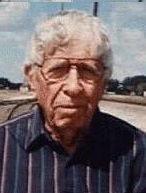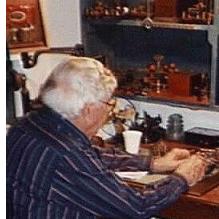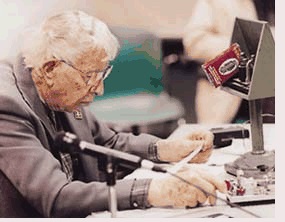
|
Aubrey E. Keel Kansas City, MO QCWA # 18770 Chapter 35 OOTC # 3128 |
AUBREY KEEL, 97, retired AP telegrapher, born July, 3, 1901, died June 25, 1999 in Kansas City, Mo. AP employed 1,500 telegraphers over a span of eight decades and Keel was one of three still living. He was hired by the AP in 1926 in Lubbock, Texas. A 16-year AP veteran telegrapher, Keel first learned Morse Code in 1917 in his hometown of Goldthwaite, Texas. As a telegrapher, he translated words into dots and dashes and transmitted them to another telegrapher on the other end of the wire, who translated the dots and dashes into words.
When the Texas AP phased in the Teletype printer in 1928, Keel adapted to the new technology. He eventually became communications chief in Milwaukee, Des Moines and Los Angeles before retiring in 1966. He continued to communicate with dots and dashes with retired telegraphers of his ham radio group, the Queen Bee Net.
He also was up on the latest technology, working out of a home command center consisting of two computers, radio gear, a digital camera, a scanner and an antique telegraph key and sounder fitted with a Prince Albert tobacco can to alter the telegraph's pitch. Last year President Lou Boccardi honored Keel at AP's 150th-anniversary exhibit opening at the Newseum in Arlington, Va. Keel demonstrated the telegraph there. He went on to repeat his Morse Code demonstrations at other AP 150th anniversary celebrations throughout the year. Keel, who suffered from lymphoma, was cremated June 26. Survivors include a daughter, a son-in-law, and granddaughter, and several nieces and nephews.
(from: http://www.rkeibler.com/retirees/archive/obits/)
AUBREY KEEL, 97, ASSOCIATED PRESS TELEGRAPHER; PASSES AWAY JUNE 25 IN KANSAS CITY, MO.
Aubrey E. Keel, one of three surviving Associated Press telegraphers and one of America's oldest World War II veterans, died Friday, June 25, 1999 in Kansas City, Missouri. He would have been 98 on July 3rd.
Cremation is scheduled with a memorial service to follow July 11 at Aldersgate United Methodist Church in Lees Summit, a Kansas City suburb. He is survived by a daughter Mari McElyea and a grand daughter, Tara McElyea 13, of Kansas City. His wife Alcia to whom he was married 44 years died in 1994.
Keel was born July 3, 1901 at Indian Gap Texas but his family soon moved to Goldthwaite. It was at Goldthwaite where at age 17, he learned telegraphy at the Santa Fe Railroad station to help relieve a World War I shortage of operators. He worked for the railroad eight years, and then was hired by the AP in 1926 to copy the news at several Texas newspapers. Greater skill as a telegrapher was required to hold down an AP job than was necessary on railroads.
 (This is a much shortened version of his Obit that appeared in the Goldthwaite Eagle. Full copy contains many highlights of his life with AP and afterwards. His full obit will be in the Obit book later this year at the Clerks office in the Mills County Courthouse. SR)
(This is a much shortened version of his Obit that appeared in the Goldthwaite Eagle. Full copy contains many highlights of his life with AP and afterwards. His full obit will be in the Obit book later this year at the Clerks office in the Mills County Courthouse. SR)
AUTOBIOGRAPHY
[The following is a short AUTO-biography from Mr. Keel who lived in Kansas, MO. until his death in June of 1999.
Mr. Keel submitted this short autobiogrlaphy in 1997.-- ray weathers]
=========================================================
Now 96 yrs old. Born July 3, 1901 at Indian Gap, Texas, Hamilton County.
Moved to Goldthwaite, Texas around 1903 where my father ran a grocery store. Attended public schools at Golthwaite.
During WW1 there was shortage of telegraph operators so I learned to telegraph at the old Santa Fe RR freight depot in Goldthwaite. Took telegraph operator job at that place, later moving to Temple Santa Fe Telegraph Relay Office.
In 1926, having become a proficient operator I signed on with the Associated Press and was employed in transmitting and receiving news reports via the telegraph which was the only means of sending messages long distances at a fast speed.
Around 1933 The AP discontinued the telegraph in favor of the Teletype automatic printers. I stayed with the AP as a Teletype maintenance man. In 1935 the AP started transmitting pictures via telephone lines and I became a Wirephoto technician, advancing in 1936 to national supervisor in New York City, a position I held until WWII when I entered the military service. I was stationed at the Fort Worth Army Flying Field (now Carswell) until I was discharged.
Returning to the AP at the end of the War I became AP Chief of Communications at Des Moines, then at Los Angles and finally at Milwaukee. I retired in 1966 after the final 25 years in Administrative work for the AP.
 My wife, Alcia also was employed by the AP and since she was ten years my junior she continued after my retirement. Her job took her to Kansas City in 1972 . She passed away in 1994 and I remained in Kansas City.
My wife, Alcia also was employed by the AP and since she was ten years my junior she continued after my retirement. Her job took her to Kansas City in 1972 . She passed away in 1994 and I remained in Kansas City.
I have one daughter Mari, and one granddaughter Tara Lynn McElyea, living next door to me. Both of us are on adjoining acreages.I am still quite active and able to take care of my acreage and home.
In 1948 I became an amateur radio operator better known as ham operators. My present ham radio call is W0AKL. (That's a zero in between the W and the A.)
Altho somewhat at novice, I own and use two computers, mostly for E-mail and word processing. I have a flatbed scanner and a digital camera, etc.
Recently the AP flew me and my galfriend to Washington where I put on a Morse telegraph demonstration at the 150th anniversary celebration of the Associated Press. Altho the telegraph is outmoded (long ago) there still is some interest in it and I have put on numerous demonstrations.
The Telegraph OfficeThe Oldest Surviving Associated Press TelegrapherAubrey Keel, W0AKL, 97 Years Young and Still Pounding Brass by Neal McEwen, K5RW k5rw@telegraph-office.com [Editor's note: I am sad to report that Aubrey passed away in June of 1999.] Copyright 1997, Neal McEwen http://www.telegraph-office.com/tel_off.html |
I'd like for you to meet an acquaintance of mine. His name is Aubrey Keel. Aubrey was born in Indian Gap, Hamilton County, Texas in 1901. He became a telegraph operator during World War I for the Sante Fe Railroad. He practiced the profession of telegraphy in various capacities until the key was replaced by teletype machines in 1933 on Associated Press wires.
I met Aubrey at the local Morse Telegraph Club fall meeting. He was the most senior member by at least two decades.
The photo at the left shows Aubrey in front of the depot in Goldthwaite, Texas, where he learned telegraphy in 1917. The photo at the right shows Aubrey at the key making a tone tape for MTC members who could not attend the meeting.
Aubrey worked for the Sante Fe for a few years, then in 1926 he went to work for Associated Press, in Temple, Texas copying news stories. AP moved him to all the large cities in Texas, most of the time in Fort Worth. Besides press he copied stock market reports after the the close of the New York Stock Exchange. He entered lots of numbers and fractions on a stock market report form.
Aubrey recalls that press and market report operators had to be extremely proficient or they did not last long. He states that all the copying was done on a typewriter, or "mill" as they were called. A single error in market reports could cause an investor untold grief.
Press operators worked in close proximity to newspaper men. To improve the throughput of press traffic, the Phillips Code was used. Commonly used words were abbreviated and standardized in the Phillips Code book. (these little pocket sized books are very rare and prized by telegraphers and collectors alike.) For example, TD was Treasury Department, CHN was children, BOP was breach of promise. By using these abbreviations the effective speed could be significantly improved. Sending operators would send 30 to 35 words per minute. On the receiving end the operator would be typing 45 to 50 words a minute, as he typed the complete word, not the abbreviation.
Aubrey continued to work for the AP even after the last Morse circuit was closed. He worked in various other capacities and retired in 1966. He currently resides in Kansas City, where his last AP assignment took him. He enjoys ham radio, CW of course, and keeps in contact with friends via the airways and the Internet.
My thanks to Macalee Hime for the photos, and Tony Smith of Morsum Magnificat and Greg Raven for biographical information. For more information on Aubrey and the history of telegraphy at AP, see the February, 1994 issue of Morsum Magnificat.